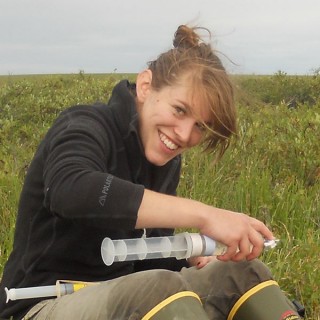Team Iron takes you into the most exclusive (science) room on the ship.

We like to throw things in the ocean
We drop the trace metal rosette down daily to collect water to measure trace metals in the upper waters of the ocean. It is easy to see why she is the most fashionable piece of sampling equipment around. As soon as she is back up on deck, we dress the Go-Flo bottles in shower caps and gloves to protect our newly collected samples from any sort of contamination. Then, we do a very intricate dance around the rosette, each scientist collecting their sample in turn, starting with helium, gases, and pH. These measurements are easily contaminated by the atmosphere, so they need to be done in order and quickly. Once that’s done, we haul the bottles inside and a lucky few of us shut ourselves “in the Bubble.”
The Bubble: what actually goes on in there?

Keeping samples clean from metal contamination while working on a metal ship is tough! We’ve essentially built a lab-in-a-lab. We’ve put up walls in the Wet Lab using plastic sheeting, and we have plastic racks mounted on one wall to hold the Go-Flos. The Go-Flos live in the bubble, except when we’re using them to collect water. We’ve hooked up a laminar flow hood to filter air from the outside and create positive pressure inside the bubble. This makes it less likely that dust and other contaminants will settle inside and accidentally get into our samples. Once we’re in the bubble, we collect water for total metal samples, and then we hook up an air system to pressurize the bottles and filter water through polycarbonate filters (0.4 µm). We collect the water that comes through the filter (filtrate), and we also collect particulate samples on a filter. Think of it like making coffee using a filter – except we want both the coffee (the filtrate) and the residual grounds on the filter (particulate).
The bubble isn’t just a clean room, it’s also a judgment-free zone, a place to share hopes and dreams, or to blast Taylor Swift, or to just think about your life as you watch the water being filtered (sometimes verrrrryyyyy slooooowlyyyyy).
Analyze this!

Once we collect our water samples, the last step is to add a small amount of acid to them to get them ready for analysis. They will be analyzed for different metals (iron, aluminum, and manganese) using Flow Injection Analysis. This method measures the intensity of the color that is produced when the metal ions in the sample react with a catalyst. The darker the color, the more metal is present. In chemistry, we say that the absorbance is proportional to the concentration (this is Beer’s law, not to be confused with beer which is also an important solution). Unfortunately, we’re still ironing out the details of our iron analysis on board the ship, but hopefully we’ll be running samples very soon. Sometimes, it’s hard to get analytical instruments going when you’ve got so many irons in the fire (or CTDs in the water, in our case).

